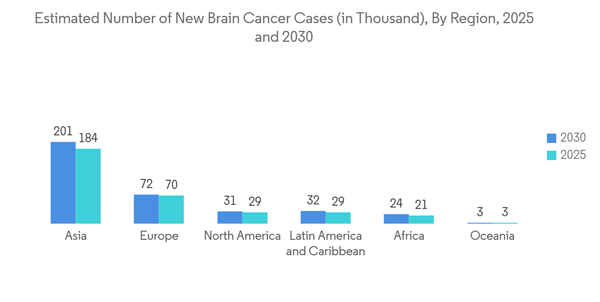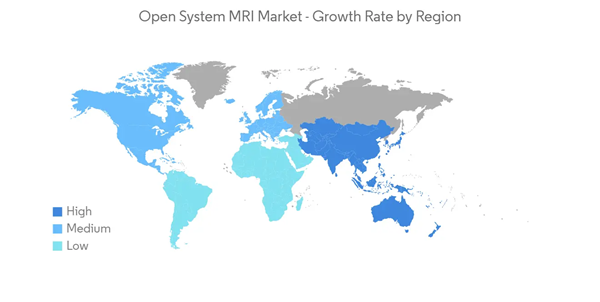The Open System MRI Market size is estimated at USD 1.54 billion in 2024, and is expected to reach USD 2.08 billion by 2029, growing at a CAGR of 5.88% during the forecast period (2024-2029).
MRI is a powerful diagnostic tool which is replacing CT because of its higher sensitivity and use of non-ionizing radiations. Open MRI is the more popular one between the two available systems of MRI, open and closed. Open MRI systems have a magnetic field in the top and bottom and do not enclose the patient in a tunnel. Open MRI is used to accommodate claustrophobic, obese and pediatric patients.
Conventional MRI scanners are a cylinder shape, while an open MRI does not completely surround your body. It is usually open on two or three sides. An Open MRI provides a more relaxed, less confining environment and lower noise levels making it less stressful for you. Therefore all these factors are supporting the open system MRI market.
For instance, the Globocan in 2020 reported that globally, around 339.7 million people are expected to suffer from brain cancer by 2025, and this number is projected to reach 435.6 million by 2040. Therefore, the growing number of people with brain cancer is likely to increase the demand for diagnosis, which will help this segment grow.
Similarly, the National Spinal Cord Injury Statistical Center reported in March 2022 that the annual incidence of traumatic spinal cord injury (SCI) was approximately 54 cases per one million people in the United States in 2021, which equals 18,000 new SCI cases each year. So, the high number of SCI cases is making more people want open-system MRI, which is helping this segment grow.
Furthermore, the launch of new products is fueling the growth of the studied market. For instance, in May 2022, Bruker launched 7 Tesla and 9.4 Tesla conduction-cooled Maxwell magnets for its market-leading preclinical magnetic resonance imaging systems portfolio. Following the success of its BioSpec Maxwell 3 Tesla model, the new range of Maxwell 7 Tesla and 9.4 Tesla magnets eliminates the need for liquid helium or nitrogen refills while offering high-field sensitivity and resolution for advanced preclinical MRI and PET/MR research. Thus, such product launches are contributing to the growth of the market.
In the same way, an article in the journal The Lancet Regional Health Americas from February 2022 said that there were 0.9 cases of brain trauma for every 1000 people in Mexico between 2020 and 2021. Hence, cases of brain trauma could increase the need for open-system MRIs, which would help the studied market grow.
The rise in MRI diagnostic procedures in the United States is expected to fuel the growth of the market under consideration. For example, a Mayo Clinic article from July 2022 said that the number of MRI diagnostic procedures went up by 40% in April 2022 compared to the same month the year before. As a result, the increase in diagnostic procedures is likely to be the main driver of market growth in the area.
The growth of this market in the region is also being driven by the release of new products. For example, Fujifilm Healthcare America Health Corporation released the Velocity MRI System in November 2021. This is a high-field open MRI system that is very advanced.The Velocity MRI system is the newest MRI scanner. Its open gantry, integrated radiofrequency (RF) coils, and reconstruction technologies are meant to speed up workflow and improve the patient experience.
As a result, more cardiovascular and neurological diseases, more diagnostic procedures, and new products are driving the growth of the studied market in the nation.
This product will be delivered within 2 business days.
MRI is a powerful diagnostic tool which is replacing CT because of its higher sensitivity and use of non-ionizing radiations. Open MRI is the more popular one between the two available systems of MRI, open and closed. Open MRI systems have a magnetic field in the top and bottom and do not enclose the patient in a tunnel. Open MRI is used to accommodate claustrophobic, obese and pediatric patients.
Conventional MRI scanners are a cylinder shape, while an open MRI does not completely surround your body. It is usually open on two or three sides. An Open MRI provides a more relaxed, less confining environment and lower noise levels making it less stressful for you. Therefore all these factors are supporting the open system MRI market.
Open System Magnetic Resonance Imaging (MRI) Market Trends
Neurology Segment is Expected to Witness Significant Growth Over the Forecast Period.
Magnetic resonance imaging is one of the most commonly used tests in neurology. MRI provides exquisite detail of brain, spinal cord, and vascular anatomy and has the advantage of being able to visualize anatomy in all three planes, such as axial, sagittal, and coronal. Thus, the neurology segment is expected to witness significant growth over the forecast period owing to the rising incidence of brain cancer, spinal cord injury, and new product launches.For instance, the Globocan in 2020 reported that globally, around 339.7 million people are expected to suffer from brain cancer by 2025, and this number is projected to reach 435.6 million by 2040. Therefore, the growing number of people with brain cancer is likely to increase the demand for diagnosis, which will help this segment grow.
Similarly, the National Spinal Cord Injury Statistical Center reported in March 2022 that the annual incidence of traumatic spinal cord injury (SCI) was approximately 54 cases per one million people in the United States in 2021, which equals 18,000 new SCI cases each year. So, the high number of SCI cases is making more people want open-system MRI, which is helping this segment grow.
Furthermore, the launch of new products is fueling the growth of the studied market. For instance, in May 2022, Bruker launched 7 Tesla and 9.4 Tesla conduction-cooled Maxwell magnets for its market-leading preclinical magnetic resonance imaging systems portfolio. Following the success of its BioSpec Maxwell 3 Tesla model, the new range of Maxwell 7 Tesla and 9.4 Tesla magnets eliminates the need for liquid helium or nitrogen refills while offering high-field sensitivity and resolution for advanced preclinical MRI and PET/MR research. Thus, such product launches are contributing to the growth of the market.
North America is Expected to Witness a Significant Growth Over the Forecast Period.
Over the next few years, North America is expected to grow a lot. This is because heart and brain diseases are becoming more common. Besides, the high number of cardiovascular (CVD) and brain disorders reported in the region is contributing to the growth of the market in the region. For example, a February 2022 NCBI article reported a higher incidence of acute myocardial infarction (MI) in Canada, with an annual prevalence of 4.97 events per 1000 population. An increase in CVDs is expected to increase the demand for diagnostic imaging procedures like MRI, thus driving the growth of the market.In the same way, an article in the journal The Lancet Regional Health Americas from February 2022 said that there were 0.9 cases of brain trauma for every 1000 people in Mexico between 2020 and 2021. Hence, cases of brain trauma could increase the need for open-system MRIs, which would help the studied market grow.
The rise in MRI diagnostic procedures in the United States is expected to fuel the growth of the market under consideration. For example, a Mayo Clinic article from July 2022 said that the number of MRI diagnostic procedures went up by 40% in April 2022 compared to the same month the year before. As a result, the increase in diagnostic procedures is likely to be the main driver of market growth in the area.
The growth of this market in the region is also being driven by the release of new products. For example, Fujifilm Healthcare America Health Corporation released the Velocity MRI System in November 2021. This is a high-field open MRI system that is very advanced.The Velocity MRI system is the newest MRI scanner. Its open gantry, integrated radiofrequency (RF) coils, and reconstruction technologies are meant to speed up workflow and improve the patient experience.
As a result, more cardiovascular and neurological diseases, more diagnostic procedures, and new products are driving the growth of the studied market in the nation.
Open System Magnetic Resonance Imaging (MRI) Industry Overview
The open system MRI market is consolidated due to the presence of a few market players operating globally and regionally. Some of the market players that operate in this segment are GE Healthcare, Hitachi Medical Corporation, Philips Healthcare, Siemens Healthcare, ESAOTE SA, and Canon Medical Systems Corporation.Additional Benefits:
- The market estimate (ME) sheet in Excel format
- 3 months of analyst support
This product will be delivered within 2 business days.
Table of Contents
1 INTRODUCTION
4 MARKET DYNAMICS
5 MARKET SEGMENTATION (Market Size by Value - USD million)
6 COMPETITIVE LANDSCAPE
Companies Mentioned (Partial List)
A selection of companies mentioned in this report includes, but is not limited to:
- GE Healthcare
- Hitachi Medical Corporation
- Philips Healthcare
- Siemens Healthcare
- ESAOTE SA
- Canon Medical Systems Corporation
- Hologic Inc.
- Nordion Inc.
- Onex Corporation (Carestream Health)
- Shimadzu Corporation
- Toshiba Corporation
- Barco N.V.
Methodology

LOADING...










